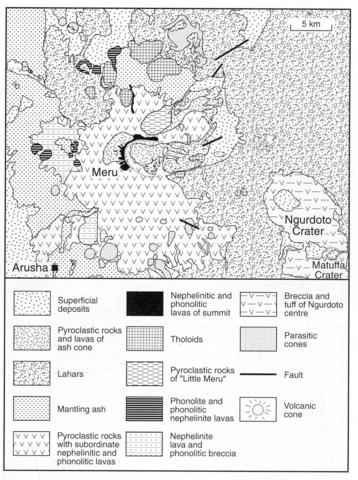stripes
The summit of Meru is at 4568 m and the products of this volcano are spread over an area of at least 60x50 km. The volcanic rocks have principally been generated through plinian eruptions but there are some lavas, lahars are widespread and there are numerous plugs (Wilkinson et al., 1983 and 1986). The earliest igneous rocks exposed are phonolites and phonolitic nephelinites of Oldoinyo Sambu northwest of the cone and in three areas on the north-northwest side. Little Meru is a volcanic cone of breccias with clasts of phonolitic nephelinite rising from beneath the northeastern flanks of Meru, and activity is thought then to have continued from the main centre which built up the present lofty cone. It comprises breccias and tuffs with occasional phonolitic and nephelinitic lavas, the former probably being the source of the extensive lahars that are intercalated with sediments around the volcano. Associated with the Main Cone group are domes or tholoids of feldspar-phyric phonolite, which are particularly abundant on the lower northern and southern flanks. After a period of erosion, activity re-commenced with outpouring of the thick Summit group phonolitic and nephelinitic lavas which formed a summit capping that has now largely gone. The summit area collapsed leaving a major breach in the eastern wall of the caldera; the collapse gave rise to lahars which cover 1500 km2 and extend 50 km to the north and 30 km to the east. It is thought that much of the ash that drapes the western side of the volcano was also ejected at this time. Final activity is confined to the 3.5 km wide caldera, which extends eastwards into a graben, and involved building of an ash cone >1000 m high on the caldera floor and formation of a lava cone from which nephelinitic and phonolitic lavas flowed onto the caldera floor and into the graben, while a flow of similar type originated near Little Meru and flowed down the northeastern flank. Ash was erupted from the volcano in 1910 and there was fumarolic activity in the ash cone up to 1954. There appears to have been no detailed petrological investigations of Meru, but analyses of a basanite and two phonolites, including trace element and Sr, Nd and Pb isotope data, will be found in Paslick et al. (1995 and 1996). Xenoliths of kaersutite pyroxenite and fenite occur in phonolitic nephelinite lavas in the caldera (Rock, 1976).
PASLICK, C., HALLIDAY, A.N., JAMES, D. and DAWSON, J.B. 1995. Enrichment of the continental lithosphere by OIB melts: isotopic evidence from the volcanic province of northern Tanzania. Earth and Planetary Science Letters, 130: 109-26.PASLICK, C., HALLIDAY, A.N., JAMES, D. and DAWSON, J.B. 1996. Indirect crustal contamination: evidence from isotopic and chemical disequilibrium in minerals from alkali basalts and nephelinites from northern Tanzania. Contributions to Mineralogy and Petrology, 125: 277-92.ROCK, N.M.S. 1976. Petrogenetic significance of some new xenolithic alkaline rocks from East Africa. Mineralogical Magazine, 40: 611-25.WILKINSON, P., DOWNIE, C., CATTERMOLE, P.J. and MITCHELL, J.G. 1983. Arusha. Geological Survey of Tanzania, Quarter Degree Sheet 55: 1:125,000. WILKINSON, P., MITCHELL, J.G., CATTERMOLE, P.J. and DOWNIE, C. 1986. Volcanic chronology of the Meru-Kilimanjaro region, northern Tanzania. Journal of the Geological Society, London, 143: 601-5.

